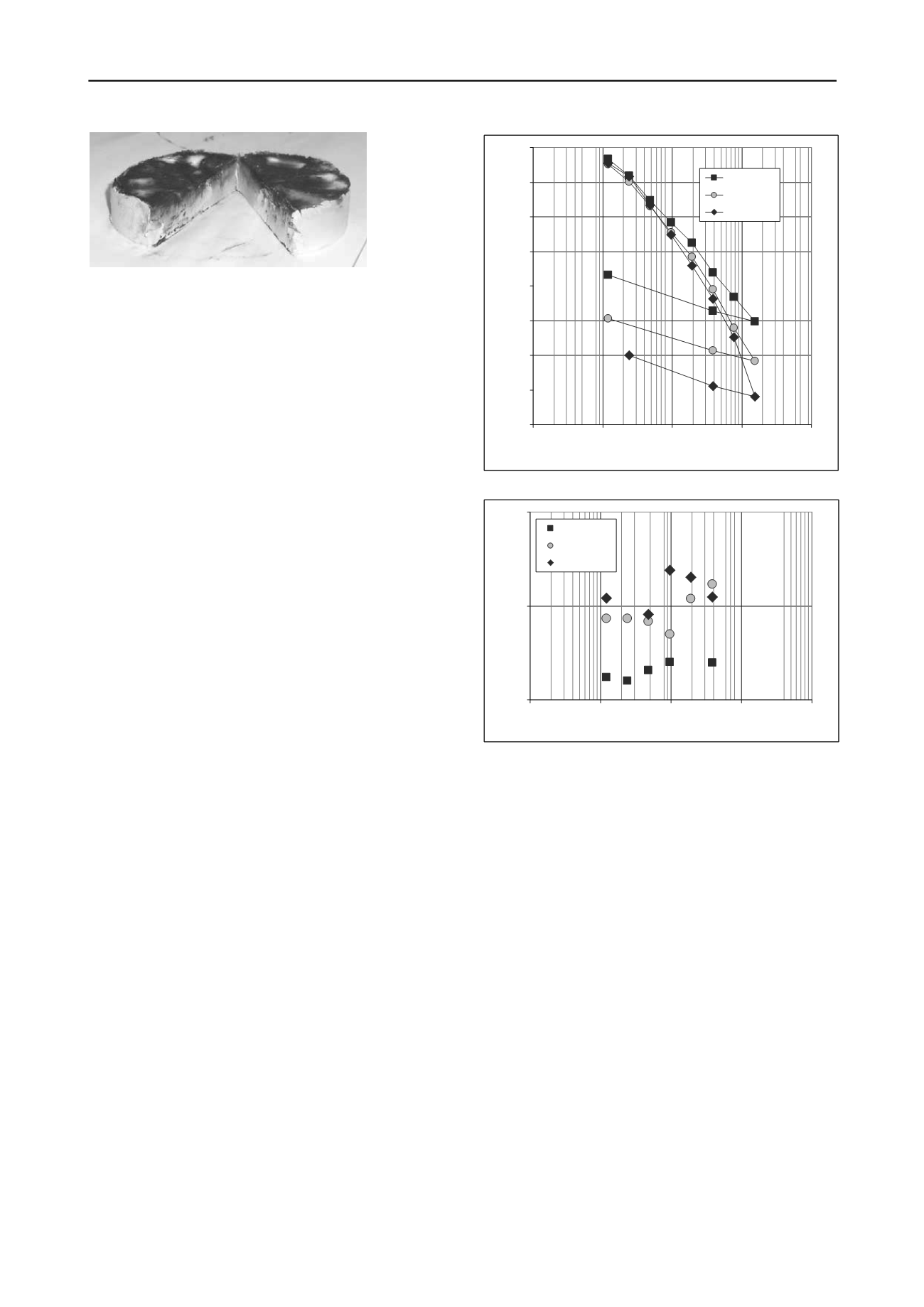
893
Technical Committee 104 /
Comité technique 104
Figure 5. Silver oxide in the top of the specimen.
4 ONE-DIMENSIONAL CONSOLIDATION TESTS WITH
ELECTROOMOSIS
Several oedometric tests were performed in order to
determine the influence of the electric current in soil
consolidation speed. Besides the reference test EC1, where there
was no application of electrical current, the cases with electrical
current allowed to study the influence of increasing voltage
(EO1 with DC voltage 9V and EO2 with DC voltage 6.35V)
and the influence of applying a reversible current flow (EO3
with DC voltage 6.35V). The stress path adopted was the same
in all cases, consisting in increasing the vertical stress each 24h:
12kPa-25kPa-50kPa-100kPa-200kPa-400kPa-800kPa-1600kPa-
400kPa-12kPa.
The influence of electroosmosis in consolidation was studied
by comparing the results of tests EC1 with those of EO1 (9.0V)
and EO2 (6.35V). Figure 6 shows the plot effective stress
vs
void ratio, where it can be seen that the electrical treatment
applied for 24h slightly increases the magnitude of the
settlements, however the compressibility characteristics of the
soil are not much affected (EC1 (0V): C
c
=0.470 and C
s
=0.128;
EO2 (6.35V): C
c
=0.541 and C
s
=0.146; EO1 (9.0V): C
c
=1.135
and C
s
=0.133).
The comparison of the results found in tests EO2 and EO1
allows understanding the influence of the applied voltage. As it
can be seen in Figure 6, the use of a higher voltage for the same
period of time (24h) increases the magnitude of the settlements.
This is because the volume of water extracted increases.
The efficiency of the consolidation process must be
measured in terms of the settlements rate instead of total
settlements, in particular because, in practice, electroosmosis is
applied during short periods of time because its effects are
visible faster and also for reducing energy costs. This rate is
measured through the coefficient of consolidation
c
v
. The main
differences between the three tests are illustrated in Figure 7. As
shown in this figure, this coefficient does not depend on the
applied stress and is higher for the tests where the
electroosmotic treatment was applied. This coefficient increases
one order of magnitude when the electrical current is applied,
which proves that the current accelerates in a significant manner
the consolidation process.
0.40
0.60
0.80
1.00
1.20
1.40
1.60
1.80
2.00
1.00
10.00
100.00
1000.00
10000.00
vertical stress (kPa)
void ratio
EC1 (0V)
EO2 (6.35V)
EO1 (9V)
Figure 6. Effective stress vs void ratio curve for EC1, EO1 and EO2.
0.01
0.10
1.00
1.00
10.00
100.00
1000.00
10000.00
vertical stress (kPa)
c
v
x10
-4
(m
2
/s)
EC1 (0V)
EO2 (6.35V)
EO2 (9V)
Figure 7. Coefficient of consolidation as function of the applied stress.
The comparison of the coefficients of consolidation
measured in all tests presented in Figure 7 shows that the values
are very similar for both tests where voltage was applied, which
indicates that the increment of voltage had no significant effect
in the time necessary to consolidate the soil for high
consolidation degrees. This may be due to the fact that the two
voltages are very similar. Further analysis on the settlements
measured in these two cases, and considering the similar
consolidation coefficients measured, showed that secondary
settlements increase with voltage, and for this reason there is a
larger reduction in void ratio for 9.0V.
Figure 8 presents the evolution of the settlements in time
under the vertical stress of 50kPa (load increment of 25kPa) for
the tests EC1 and EO2 (6.35V). When the two curves are
compared it can be seen that the settlements measured in EC1
after 24h (at the end of the consolidation) were reached in test
EO2 about 4h after the application of the load increment. It can
be seen also that settlements increase in time with constant rate
when electroosomosis is applied, which indicates important
secondary consolidation.
To conclude, 4h was the time needed in each load step of
EO2 to achieve the settlement measured in EC1 at the end of
consolidation in this test. This means that consolidation using
electroosmosis was about 6 times faster than in the other cases
if any type of treatment is adopted. Similar values were found
for each loading increment, as well as for test EO3(6.35V)
where reversible current was applied for load increments with
the duration of 24h each. This last test had the advantage of
reducing the formation of silver oxide.


